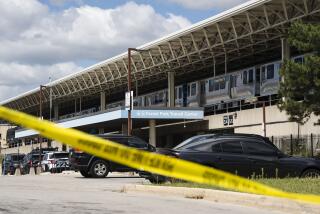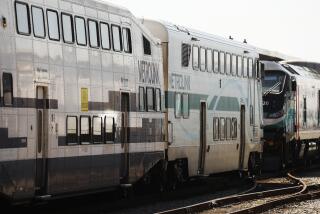New York train was speeding when it derailed

NEW YORK — A speeding passenger train barreled into a sharp curve about 82 mph when it should have been traveling 30 mph, and there was no attempt to slow down until “very late in the game,” investigators said Monday.
Four passengers were killed in Sunday’s derailment, the worst in the 30-year history of the Metro-North Railroad, and more than 60 people were injured. All the wounded were expected to survive. About two dozen remained hospitalized Monday as the first details of the National Transportation Safety Board’s inquiry brought calls for stricter safety standards. It was the first Metro-North crash to involve passenger fatalities, but the third serious incident involving the railroad since May.
At a news briefing, Earl Weener of the NTSB said two “event recorders” retrieved from the wreckage had provided investigators with details on the speed, brakes and throttle control on the seven-car train, which went off the tracks at 7:20 a.m. about 10 miles north of its destination, Grand Central Terminal.
“The preliminary information … from the event recorders shows that the train was traveling at approximately 82 mph as it went into a 30-mph curve,” Weener said. “That speed, again, was 82 mph.”
That exceeds the 70-mph speed limit on the straight portion of track.
The brakes weren’t fully applied until just five seconds before the engine stopped, Weener said. By then the train, including the engine, was careening off the rails, and it was far too late to stop the catastrophic derailment that sent train cars rolling onto their sides and sliding down a hill toward the Harlem River.
Three of the four people who died were thrown from the train. Rescue workers had to cut through a tangle of metal, glass and broken seats to reach victims inside the cars. People living nearby described loud bangs and the screech of metal on metal.
Weener’s announcement confirmed what some passengers on Metro-North’s No. 8808 out of Poughkeepsie, N.Y., had said: that the train seemed to be going too fast as it entered the notorious curve in the Spuyten Duyvil section of the Bronx. But he said the reason for the excessive speed — mechanical failure, operator error or some other factor — had not been determined.
“It tells us what happened. It doesn’t tell us why it happened,” he said of the information on the event recorders.
Investigators have begun interviewing the train’s operator, William Rockefeller, who has been an engineer for Metro-North for more than 10 years. They also took his cellphone to determine whether he was distracted at the time of the derailment. Weener said no details of the interview would be released until after three other members of the train’s crew had been interviewed and until investigators were finished speaking to Rockefeller. Results of toxicology tests were not available, he said.
Rockefeller, 46, who lives in the upstate New York town of Germantown, about 110 miles from New York City, was among the injured.
James Reardon, mayor of Rhinebeck, N.Y., where Rockefeller attended school, described him as “a conscientious and dedicated guy,” the Poughkeepsie Journal reported. “I have to believe this was some type of mechanical problem,” Reardon said.
Whatever the cause, some lawmakers said the crash underscored the need for a full safety review in light of other incidents, including a May collision between two trains that injured more than 70 people. Eleven days after that crash, a Metro-North track foreman was fatally struck by a train on a section of track that was not supposed to be in service.
Sen. Charles E. Schumer (D-N.Y.), who joined Weener and Sen. Richard Blumenthal (D-Conn.) at the news briefing, said when he learned of the train’s speed, “I gulped.”
“For a train to be going around that curve is just frightening,” Schumer said, noting that at 82 mph, the train was also exceeding the 70-mph limit on the straight section of track before the curve. “The fact it was going 82 mph even in the 70-mph zone … raises so many questions, and it’s scary.”
Schumer noted that the train made nine stops before the crash without problems. “So clearly the brakes were working a short time before the train came to this curve,” he said.
On a street near the crash site, mourners gathered Monday evening for a vigil to remember the victims: Jim Lovell, 58, a family man headed into the city to help light the Rockefeller Center Christmas tree; Donna L. Smith, 54, traveling to Manhattan for an outing with her sister; James M. Ferrari, 59, a building superintendent described by his wife as a “wonderful husband, a wonderful daddy”; and Kisook Ahn, 35, a pediatric nurse going home after a night shift.
“It’s just so sad that he’s gone,” Lovell’s son Finn, 17, said outside the family’s home in Cold Spring, N.Y., north of New York City.
Lovell was a technician who had worked on “Today” and other NBC shows and who each year helped prepare the huge Christmas tree at Rockefeller Center for its lighting, which takes place this week.
Ferrari’s wife, Francine, wept as she spoke to reporters at her home in Montrose, N.Y., about her husband, a regular rider on the early-morning train. “He’s the best,” she said. “I miss him so much.”
Smith, a paralegal, lived in Newburgh, N.Y., and often went to Manhattan with her sister, Linda, to shop or see shows. Friends and neighbors said she volunteered with the Girl Scouts and several charities. “She was kind, neighborly, friendly,” her neighbor Kathy Cerone said. “She was very good-hearted. Just a great neighbor.”
Colleagues described Ahn, whose family is in Korea and who had come to the United States in 2009, as a hard-working and popular nurse at the Sunshine Children’s Home and Rehab Center in Ossining, N.Y. “She never left her shift without saying goodbye to everybody. She was a very warm, loving person,” said the facility’s administrator, Linda Mosiello.
More to Read
Sign up for Essential California
The most important California stories and recommendations in your inbox every morning.
You may occasionally receive promotional content from the Los Angeles Times.











